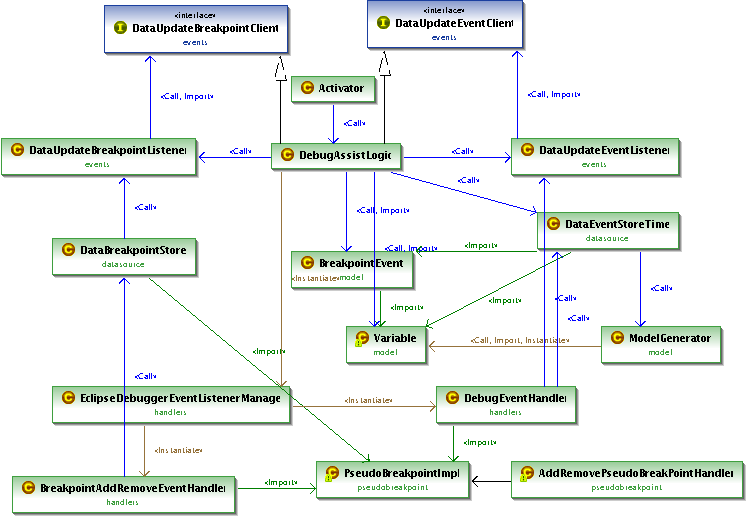James Ashford Design Study
m (→Design Critique) |
m |
||
| Line 39: | Line 39: | ||
== Initial Design == | == Initial Design == | ||
One Word: horrible. | One Word: horrible. | ||
| − | + | ||
| + | == UML Diagram == | ||
| + | [[image:Jra82_firstdesign_uml.png]] | ||
| + | |||
| + | |||
=== Description of Classes === | === Description of Classes === | ||
'''debugassist:''' | '''debugassist:''' | ||
| − | * Activator (extends | + | * Activator (extends AbtractUIPlugin) - Activator class which is run when the Plugin is loaded |
* DebugAssistLogic (implements DataUpdateBreakpointClient, DataUpdateEventClient) - Provides some basic functions to clean up breakpoint data, contains 2 clients which are activated when a breakpoint is inserted/updated/remove and when a breakpoint is 'hit' | * DebugAssistLogic (implements DataUpdateBreakpointClient, DataUpdateEventClient) - Provides some basic functions to clean up breakpoint data, contains 2 clients which are activated when a breakpoint is inserted/updated/remove and when a breakpoint is 'hit' | ||
Revision as of 01:29, 27 July 2010
Contents |
My Project
As part of my honours project, I am developing a plug-in to Eclipse to help illustrate how the state of software changes during runtime. My design study will focus of the data collection subsystem of my project.
Data collection works by inserting a data collection point into a line of code in your document. Every time the application hits this data collection point, a copy of all variables in scope (local, instance and static variables) are recorded and the program resumes. At the conclusion of runtime, the user can review what happened and generate visualisations.
There are two main areas in the data collection subsystem namely:
1. Management (inserting / deleting of data collection points etc)
2. Event Handler (whenever the data collection point is encountered)
Management
A data collection point is a thinly disguised breakpoint which is handled along side normal Java breakpoints. The management side controls the creation and deletion of the data collection point.
Event Handler
Whenever a breakpoint is encountered, the following logic occurs:
1. Event Handler is notified that a breakpoint has been hit
2. Event Handler checks to see if it was a PseudoBreakpoint
3. If so, do data collection
4. Event Handler checks to see if there was another breakpoint also hit (a normal breakpoint)
5. If so, suspend application (so normal breakpoint activity can occur)
6. Else resume program
Design Study
Requirements
- Maintainability - Easily add new features (such as different data sources etc)
- Extensible - Add additional programming languages (such as PHP etc) easily
Constraints
As this is an Eclipse plug-in, our design must fit the Eclipse model.
Initial Design
One Word: horrible.
UML Diagram
Description of Classes
debugassist:
- Activator (extends AbtractUIPlugin) - Activator class which is run when the Plugin is loaded
- DebugAssistLogic (implements DataUpdateBreakpointClient, DataUpdateEventClient) - Provides some basic functions to clean up breakpoint data, contains 2 clients which are activated when a breakpoint is inserted/updated/remove and when a breakpoint is 'hit'
debugassist.datasource:
- DataBreakpointStore - Stores all the pseudo breakpoints in a HashSet.
- DataEventStoreTime - Store all the data when a breakpoint is hit.
debugassit.events:
- DataUpdateBreakpointClient - An interface which needs to be implemented if you wish to listen to Breakpoint Events (i.e. when a breakpoint is added/removed etc)
- DataUpdateBreakpointListener - The service which handles Breakpoint listener clients (where clients subscribe to events etc)
- DataUpdateEventClient - An interface which needs to be implemented if you wish to listen to Breakpoint Data Events (i.e. when a breakpoint is encountered by the debugger).
- DataUpdateEventListener - The service which handles Breakpoint data listener clients (where clients subscribe to events)
debugassist.handlers:
- BreakpointAddRemoveEventHandler (implements IBreakpointListener) - handles the breakpoint events from Eclipse (i.e. when a breakpoint is added / removed from Eclipse) - and notifies DataUpdateBreakpointListener.
- DebugEventHandler (implements IDebugEventSetListener) - Handles the breakpoint hit events from Eclipse (i.e. when a breakpoint is hit within Eclipse) - this performs data collection (collects all variables in scope), and notifies DataUpdateEventListener.
- EclipseDebuggerEventListenerManager - Attaches BreakpointAddRemoveEventHandler and DebugEventHandler to Eclipse.
debugassist.model:
- BreakpointEvent - A model for whenever a breakpoint is hit by the debugger (stores time, variables)
- ModelGenerator - A utility class for converting IVariable (Eclipse type) to Variable (our model type)
- Variable - A model for a Variable
debugassist.pseudobreakpoint
- AddRemovePseudoBreakPointHandler (extends AbstractRulerActionDelegate) - Pseudobreakpoint handler type - so users can right click in Eclipse to add/remove a breakpoint.
- PseudoBreakpointImpl (extends JavaLineBreakpoint) - The breakpoint used to represent our Pseudobreakpoint. It is actually just a JavaBreakpoint with a different type and icon so the DebugEventHandler knows which breakpoints to collect.
Design Critique
Initial Design
Quick notes:
- The packages are a mess. Everything is in the wrong place
- DebugAssistLogic doesn't seem to do much, needs a reorg - most functions could be placed in Activator
- DebugEventHandler handles the Breakpoint data events - which it really should be a DataUpdateEventListener
- DataUpdateEventListener & DataUpdateBreakpointListener SHOULD be the ones themselves which handle the Eclipse events (the debugassist.handlers are unnecessary)
- The names of the classes need to be changed
- ModelGenerator should be fixed (I'm not sure I actually need it???)
- The Pseudobreakpoint classes should be fixed up - It's directly extending the Javabreakpoint class!!!!
Design Improvements
I've added this, i've removed this
Files
Media:debugassist-swe_init.zip - The initial design.
Installation
- Download & Install Eclipse 3.5.2 (with SDK)
- Extract the zip file of my project
- Run Eclipse
- Click File -> Import -> Existing Projects into Workspace
- Select root directory of extracted plugin
- Click Finish
- Create a new Run Configuration: 'Eclipse Application'
